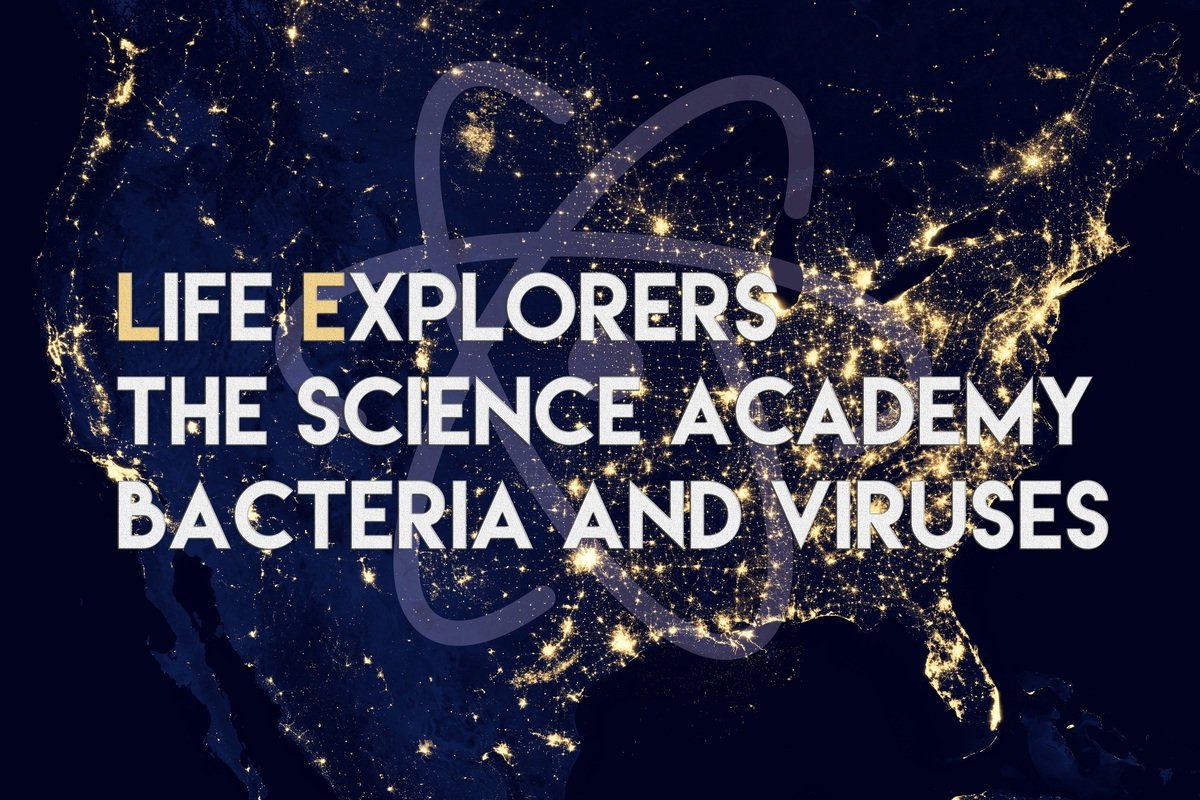
Welcome to Life Explorers – The Science Alliance, a series in which we will cover scientific points of views and explain fundamental knowledge. This series addresses the wonders of nature and bringing back its magic. To the Science Alliance it is not enough to see processes or phenomena, we want to understand. We will ask the “how’s” and “why’s”, and we will give an insight into the world of science.
Today’s article is about bacteria and viruses. The first thoughts are commonly negative and associated with diseases or infection, but bacteria saves lives, helps us daily, and there is more than just the common cold flu. We will first have a look at what bacteria and viruses are, investigate the differences and last but not least why they harm or even help us.
Bacteria
Before we investigate the nature of bacteria we need to have a closer look at the different types of organisms. Fundamentally, we distinguish between eukaryote and prokaryote organisms. Eukaryote cells contain a nucleus and other complex organelles which are enclosed with a double-membrane. This double-membrane separates the organelles from the cellular space and make them organized as organelles. Animals, plants and fungi are made of eukaryote cells. The following figure illustrates the characteristics of an animal cell.

Fig.1 Structure of an animal cell.Credits
In the middle we can see the nucleus, which contains the DNA (deoxyribonucleic acid). Besides the nucleus, other characteristics of organelles in animal cells are the mitochondrions, Golgi vesicles and endoplasmic reticulums, each with a specific purpose. As we are discussing bacteria and viruses, we will not go further into the function of the animal cell. (If you are interested about the different cell organelles and their function leave a comment and I will write another article.)
On the other side there are the prokaryote organisms. Prokaryotes are single-celled organisms containing no nucleus, meaning the DNA is exposed in the cellular space. Comparing the two schemes we notice the absence of several organelles. Those with a double-membrane are not included in prokaryotic cells. The figure below depicts a common bacterium. Note that not all structural elements are existing on all bacteria, there are different types and forms of bacteria. Nevertheless, there are structures all bacteria have in common: plasma membrane, cytoplasm, ribosomes and the nucleoid. Don’t be confused because I told you bacteria have no nucleus. Nucleus and nucleoid are two different, though similar, things. The nucleus contains the DNA which is separated from the cytoplasm, whereas the nucleoid is close-packed DNA string and located within the cytoplasm. The nucleoid can be considered as the equivalent to the nucleus.
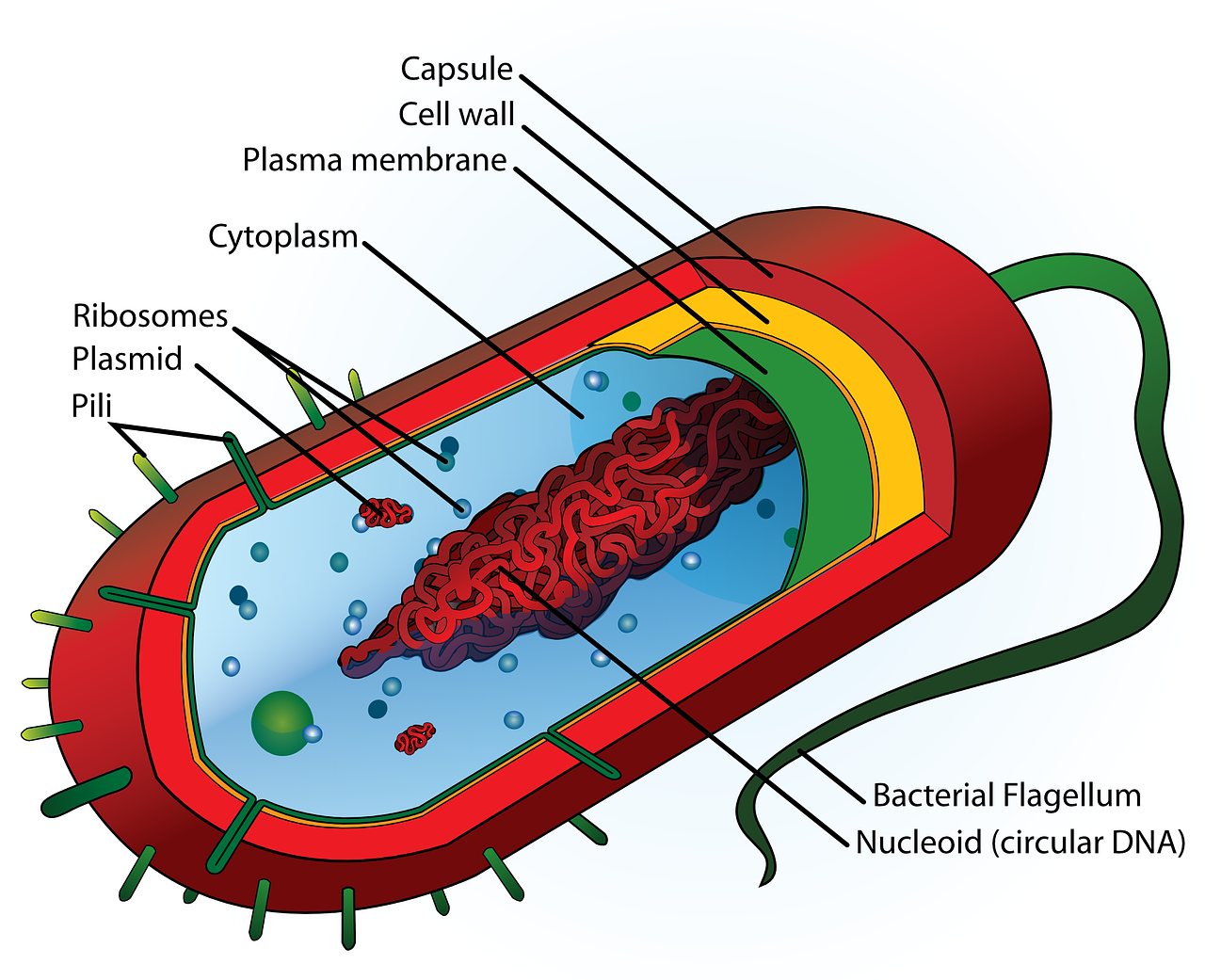
Bacteria appear in different shapes and we distinguish between the main forms (spherical) Cocci, (rods-shaped) Bacilli, spiral (Spirilla), corkscrew (Spirochaetes). Besides these forms they can appear in many other various shapes. Single bacteria can join in pairs and are able to build clusters. A good overview over shapes and groups delivers the following illustration.

Fig.3 Different shapes of bacteria. Credits
Bacteria a living organisms
Bacteria are living organisms but what are the biological indicators for life? We need to meet four main requirements to speak of life: reproduction, metabolism, irritability and growth. The capability of evolution plays also an important role. We will further discuss the reproduction of bacteria. Biological reproduction follows a certain mechanism we will investigate: Mitosis and Meiosis.
Mitosis
Mitosis is a stage in the cell cycle which produces two identical daughter cells from one mother cell. The mitosis runs in 6 stages:
Interphase: Is the phase between two mitoses and serves the preparation of the next mitosis. Is the longest phase which takes up to 90% of the cell division cycle. The interphase itself is not part of the mitosis, but is responsible for the DNA replication.
Prophase: The DNA in the nucleus has the form of a double helix. This double helix is wrapped around certain proteins. During the prophase the DNA is packed more densely and changes it appearance. The process is called DNA condensation. The chromosomes are now visible under a light microscope (See figure below). Mitotic spindles are built, which will later separate the chromosomes.
Metaphase: The spindles align the chromosomes in the equatorial plane. This is important to make sure that the next phase works correctly.
Anaphase: The two chromosomes are separated in the middle (kinetochores) and pulled towards the opposite sides of the cell.
Telophase: The separated chromosomes reached the opposite side of the cell and the daughter cells start to build their own membrane. The DNA condensation is reversed.
Cytokinesis: Two daughter cells with an own nucleus each are produced. The mitosis is finished.
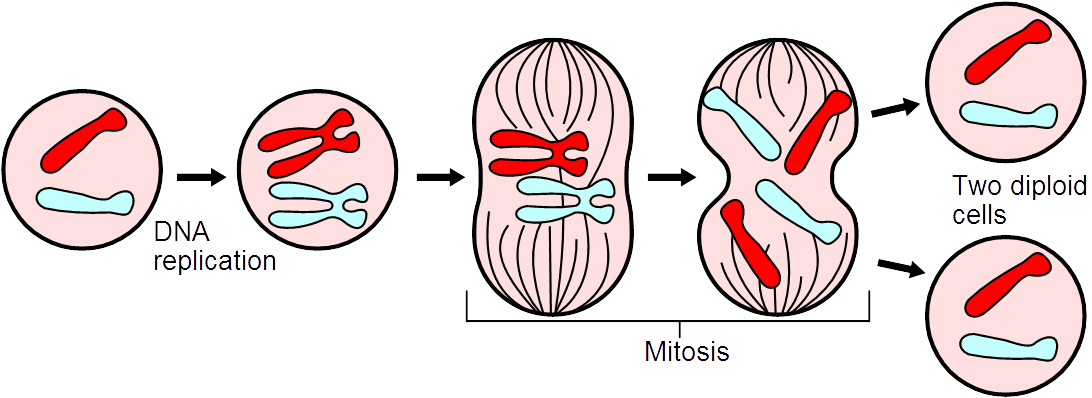
A short note about the DNA packing. As told DNA is a double helix string which however has different appearance. During mitosis the condensation of DNA happens which puts the double helix into the form of chromosomes.
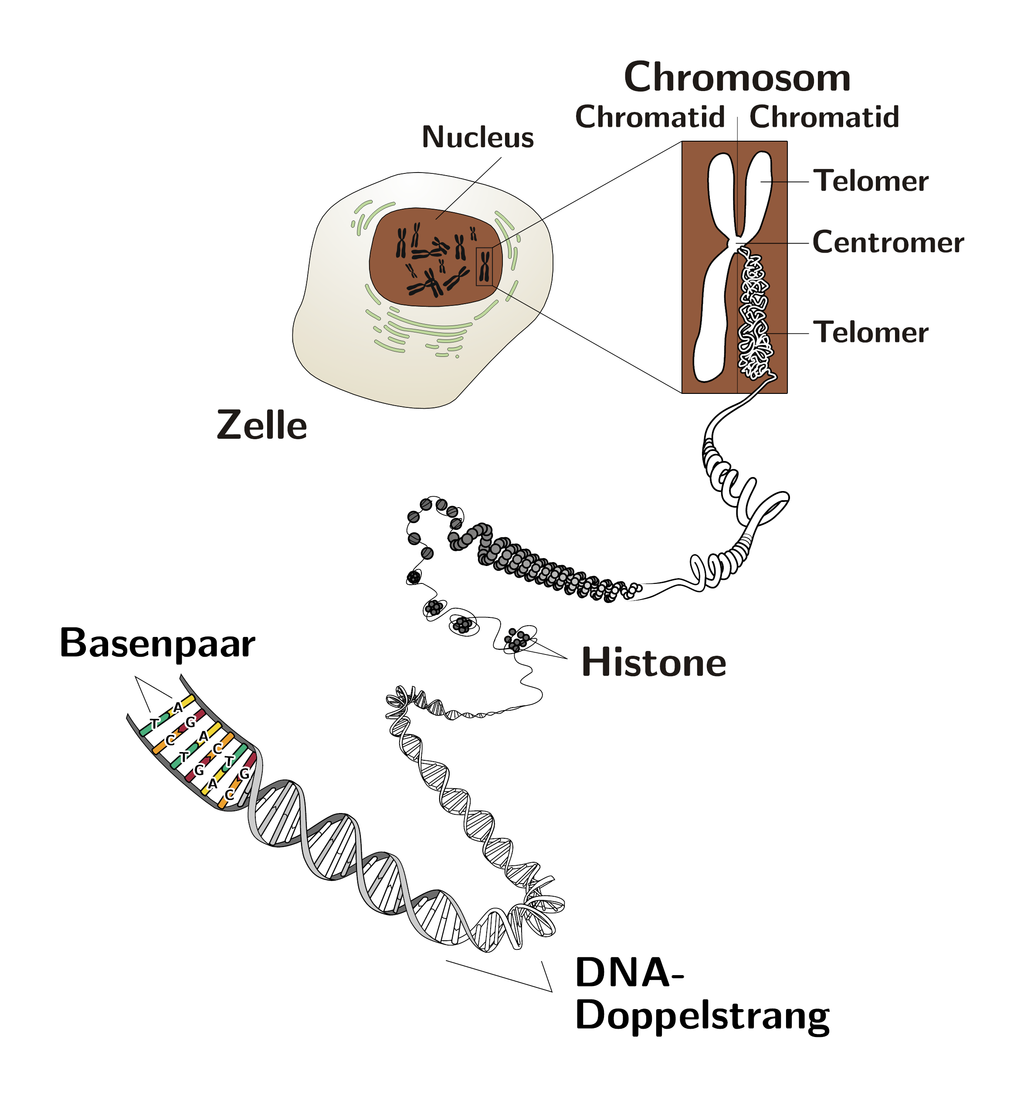
The meiosis is also a form of cell reproduction, but the daughter cells are not identical. Meiosis plays a great role in sexual reproduction where we need to mix the chromosomes to create a new and unique individual. If sexual reproduction by humans would follow only mitosis we all would look the same and there would be no different genders. As bacteria are asexual they only reproduce through mitosis.

The bacteria reproduction follows a certain pattern that has four stages:
Seed stage (lag phase): The bacteria adapt to the environment. This phase is usually slow in order to prepare the real growth. The preparation comprises an analysis of the available nutrients.
Log phase (exponential phase): The actual growth happens here. The bacteria start to replicate at maximum speed. The more nutrients that are available, the faster the reproduction.
Stationary phase: The nutrients are consumed and the available space is covered. The growth slows down as the metabolism slows down.
Death phase: The bacteria die due to the lack of nutrition or waste products of other bacteria.
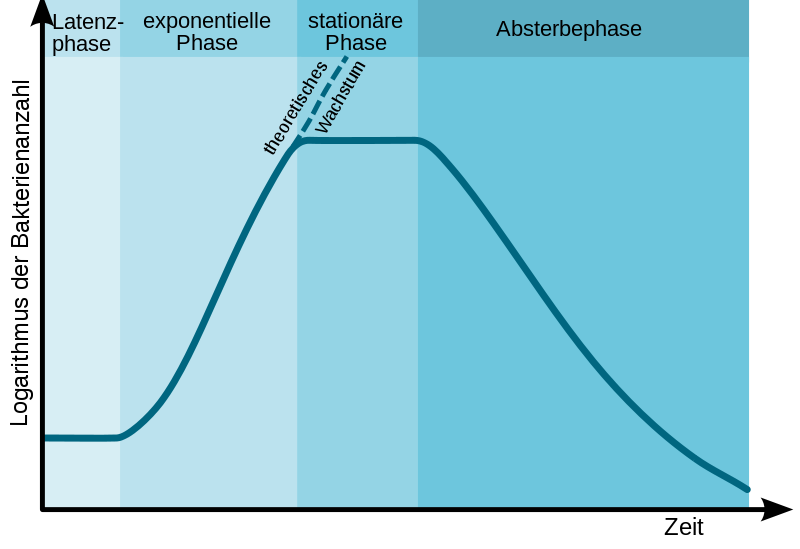
So that we know what bacteria are and how they reproduce we will have a look at viruses.
Viruses – living organisms?
Viruses are small particles that can be considered parasites. To be accurate we must distinguish between a virion and a virus. A virion is a virus particle outside a cell and a virus is a particle inside the host cell. We saw that bacteria are able to reproduce by themselves and fulfill the criteria for life. Viruses however depend on living cells of other organisms. They can’t reproduce by themselves. This results in a thin line between living and nonliving. On the one hand they contain the information for life, DNA, but on the other hand they have no reproductive capability of their own. Being accurate we will consider viruses as non-living particles.
Virions usually are one-hundredths of the size of a bacterium and consists of two parts: the genetic information (DNA or RNA) and a protein coat.
The following figure depicts a HI-virion (note that the HI-virion has lipids covering the surface; there exist many more different types of virions)
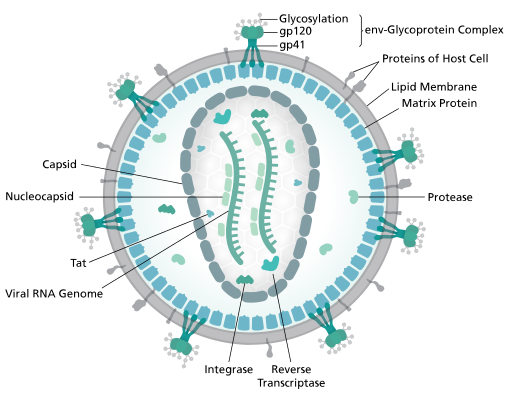
So, viruses need a host cell to reproduce. We will now cover the replication of viruses in a bacterial cell. Virions that infect bacterial cells are called phage.
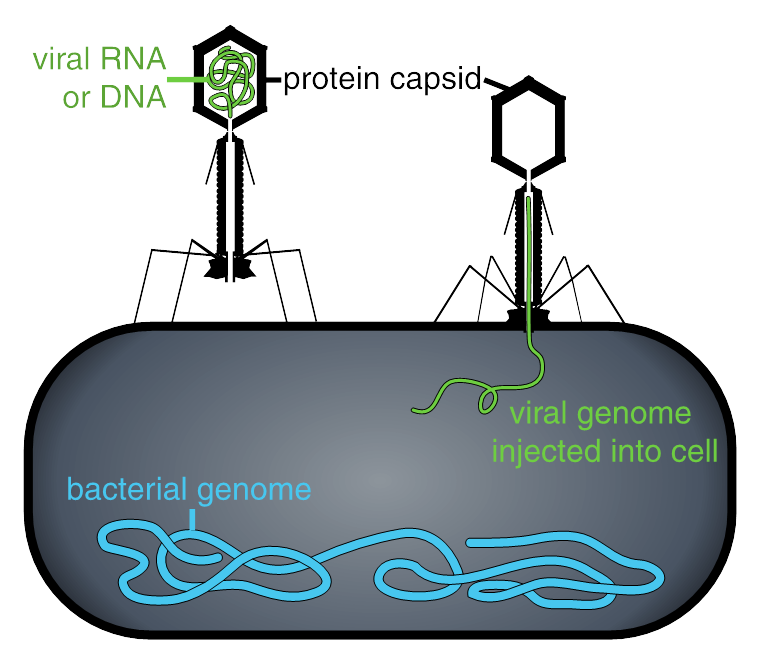
There are four basics stages of the infection. The first stage is the contact where the bacteriophage is approaching the cell and docks on the surface. The phage has thin pipes that are needle-like and help it inject it’s viral RNA or DNA. Once the viral RNA is inside the cell it is detected as the cells own RNA or DNA and starts to be expressed. This causes the cell to produce the components of the phage. Around 100 to 200 phages will be built in the cell. After these phages are built the cell starts dying and the new phages will infect more cells. The mechanism is quite similar to the infection of human cells.
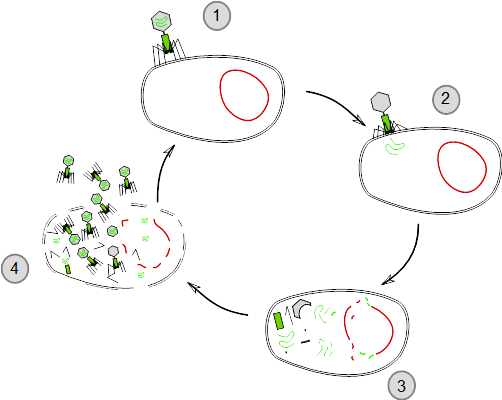
What are bacteria and viruses causing in humans?
Both, bacteria and viruses can cause serious diseases. Viruses are known for Aids, yellow fever, smallpox, measles, influence and many more illnesses. Bacteria can cause salmonellae, tuberculosis, scarlet fever and more. While bacteria can be treated with antibiotics there is no medication for viruses. Most drugs fight against the symptoms and not the actual virus. That’s why it is important to rest when infected with influenza. The body needs time to fight the virus and recover. We will make another article on how the immune system battles against germs and how antibiotics work.
Why are bacteria important?
Bacteria are double-edged swords in that they can cause harm but they are also essential for our life. In and on our body are approximately two kilograms of bacteria. In the year 1977 Dwayne Savage from the Department of Microbiology of the University of Tennessee found out that 1/10 of the cells in the human body are bacterial. So how does it happen we are still alive? We have bacteria in our intestine for instance that help us to digest, they are part of the immune system. Bacteria on our skin, for instance, protect the skin from bad bacteria and more. We can use bacteria to produce antibiotics and other chemicals like ethanoic acid.
So before you sleep tonight, think of all the millions and billions friends inside, and on, you that keep you happy, healthy, and alive :)
The Life Explorer Series is a community magazine that brings together writers to post about a variety of topics. All topics and authors using the lifeexplorer tag or title are part of this group and have permission to post under the heading Life Explorer. If you would like to write with the Life Explorer series about a topic, reach out and get in chat contact with. Feel free to follow us and support us this way. @timsaid to learn more.
Make sure to catch all these Life Explorer authors:
@prufarchy
@yogi.artist
@disofdis
And if you've missed the previous edition, check out the first Life Explorer post:
Life Explorers - The Human Senses Part I: Sight
Life Explorers - The Human Senses Part II: Hearing
Life Explorers - The Human Senses Part III: Touch
Life Explorers - The Human Senses Part IV: Taste

